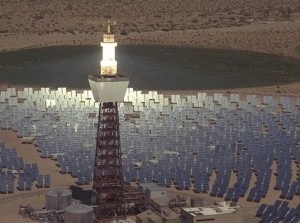By: Dr. John Kyndt ( Head Scientist of the Renewable Energy Program at Advanced Energy Creations Lab)
 We tend to focus our blogs on the conversion of solar energy into liquid transportation fuels, but the alternative of solar for electricity has recently been in the news with a couple of impressive large scale operations.
We tend to focus our blogs on the conversion of solar energy into liquid transportation fuels, but the alternative of solar for electricity has recently been in the news with a couple of impressive large scale operations.
On December 21, DOE announced it has finalized a $1.45 billion loan guarantee for Abengoa Solar Inc.’s solar project near Gila Bend, Arizona. This impressive Arizona project is called Solana and will have a 250-megawatt (MW) capacity.
It is believed to be the world’s largest parabolic trough concentrating solar plant. In a solar trough, synthetic heat transfer oil is heated up as it passes the trough. Energy in the oil is used to generate superheated, high pressure steam that is delivered to a steam turbine. This turbine powers an electrical generator, creating electricity.
The Arizona solar project is the first large-scale U.S. solar plant capable of also storing the energy it generates. Solana will produce enough energy to serve 70,000 households and will avoid the emissions of 475,000 tons of carbon dioxide per year compared to a natural gas burning power plant.
Solana will be constructed like its smaller 50 MW sister plant Solnova1 (located in Sevilla, Spain) with the addition of storage capacity. More than 900,000 mirrors will be manufactured in a facility close to Phoenix. Electricity from the project will be sold through a long-term power purchase agreement with Arizona Public Service Company.
In addition, news was also released in December that the solar plant developer SolarReserve is going ahead with the purchasing of materials and equipment for two large solar projects in California and Nevada. This involves a 110 MW Crescent Dunes Energy Project in Nye County, Nevada and a 150 MW Rice Solar Energy project located in Riverside County, California
Both projects have secured 25-year power purchase agreements, one with Nevada Utility NV Energy and the other with Pacific Gas & Electric Company (PG&E). Currently SolarReserve is aiming to secure a loan guarantee from the US Department of Energy to support the two projects.
SolarReserve technology is somewhat different from the Arizona Solana project in that it uses a so called “power tower”. It involves use of fields of mirrors, known as heliostats, which collect sunlight and focus it on a receiver located in a central tower.
In the tower, it heats a molten salt to more than 1,000 degrees Fahrenheit, for use producing steam to drive a power-generating turbine. Both projects are projected to break ground in 2011 once permitting and anticipated DOE financing is completed.
Also in early December last year the switch was flipped on America’s largest photovoltaic solar power plant, which is also located in Nevada (Boulder City). This 48-MW Copper Mountain Solar facility is now generating enough renewable energy to power approximately 14,000 homes.
Sempra Generation (a subdivision of Sempra Energy) constructed the plant beginning January 2010 on 380 acres of desert 40 miles southeast of Las Vegas. On December 1, Sempra Generation officials announced that construction was complete and that emission-free electricity was being generated. The power has already been sold to PG&E under two separate 20-year contracts.
Sempra Generation already has plans to begin its next PV plant construction projects, including a major 600-MW plant in Arizona.
Arizona has positioned itself to become the “Mecca of Solar Energy”, which seems a smart investment and the idea goes around that the state puts itself in that position to become an exporter of its most abundant resource: solar energy.
Other emerging solar based technologies, such as algae for biofuel, are expected to contribute to this image. The recent announcement of the state funded Arizona Center for Algae Technology and Innovation (AzCATI) is a promising step in that direction.
Placing bets on multiple alternative energy solutions makes sense in times where none of them have provided an ultimate resolution. For example, solar makes sense in the Southwest US, but other places are better off using e.g. wind energy.
The true solution to energy independence will need to come from a combination of technologies and potential hybrid technologies, combined with continuous innovations that increase their efficiency and scalability.



[…] Solar Giants on the Rise in the Southwest US AKPC_IDS += "439,";Popularity: unranked […]
[…] Solar Giants on the Rise in the Southwest US AKPC_IDS += "195,";Popularity: […]